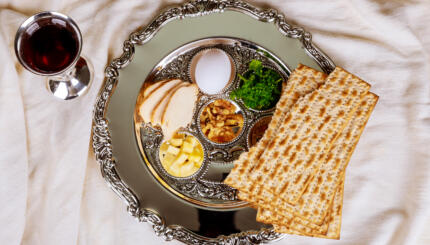It’s Passover. Except that it isn’t, not yet. This year, Passover begins the evening of April 10, but I attended my first seder on Sunday. Jews celebrate Passover with a special meal and ritual, a seder, on the first and second evening of the eight-day holiday. Instead of just two, though, I routinely attend at least four Passover seders each year, and I lead or help to lead most of them.
Yesterday I helped lead a community interfaith seder with a priest, an imam, a rabbi and a cantor. This coming Saturday in my congregation we will hold a model seder for our religious school. I’m hosting a 26-person seder in my home on the first night of Passover, and on the second night I’m co-leading a community seder for about 60 people. In past years I’ve led seders that focus on the experience of women, and I’ve written a Haggadah (unpublished) honoring the experience of Jews by choice.
READ: How to Make Your Own Passover Haggadah
This proliferation of seders is sometimes a little overwhelming, but it is also a testament to the power of this holiday. The story of the exodus from Egypt, the Israelites’ going from slavery to freedom and becoming a nation, remains compelling. Groups who are oppressed and struggling for freedom identify with this story, including the founders of the USA and African-Americans in the Civil Rights Movement of the 1960s.
It is also a potent story on a personal level. Most of us have elements of our lives or our psyches that feel constrictive in an unhealthy way. The exodus is not just about literal freedom from slavery for a group; it is also about becoming more free on a personal level from whatever we feel is holding us back.
Then there is the way we celebrate, which amplifies the power of the story. A festive meal is preceded by storytelling with ritual foods that all have meaning: Parsley dipped in salt water represents the renewal of spring while acknowledging tears of pain. Matzah, unleavened bread made in under 18 minutes, symbolizes both affliction and freedom. Charoset, a chunky mixture of chopped fruit and nuts with a little sweet wine, represents mortar used by slaves when building with bricks. Horseradish or romaine lettuce represents the bitterness of slavery. A lamb shank bone (or a beet, for vegetarians) represents the Passover sacrifice that took place for centuries when the Temple stood in Jerusalem. We pour some of the wine out of our cups when we remember how the Egyptians suffered from the 10 plagues.
READ: How to Choose a Passover Haggadah
Dozens of Haggadot exist applying the symbols and rituals of the Passover seder to different kinds of experiences of oppression and struggles for freedom. They include Haggadot about women, immigrants, the environment, vegetarianism, LGBTIQ people, hunger, and more. The rabbis of Jewish tradition, who developed Passover observance in the first century CE into the Passover seder, were geniuses. They created a structure that encourages and allows exploration and discussion of not just the origin story of the Jewish people, but the struggles for freedom — both personal and communal —s ince then and continuing today.
May we all move toward freedom this spring, in whatever way we need to, and may we turn our attention to those who are struggling to be free.



